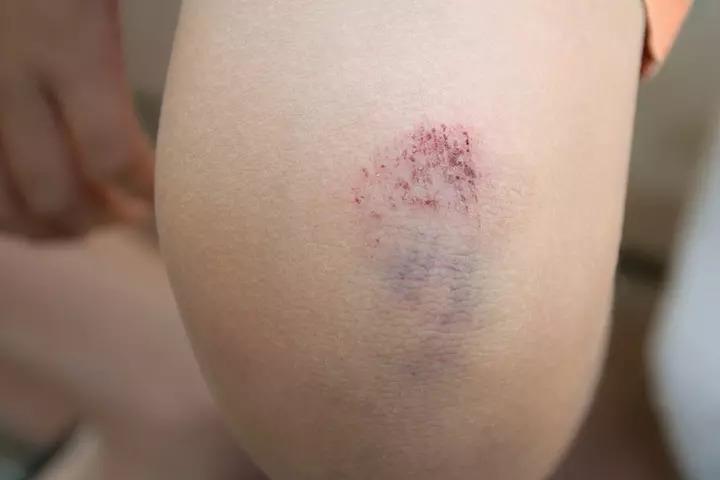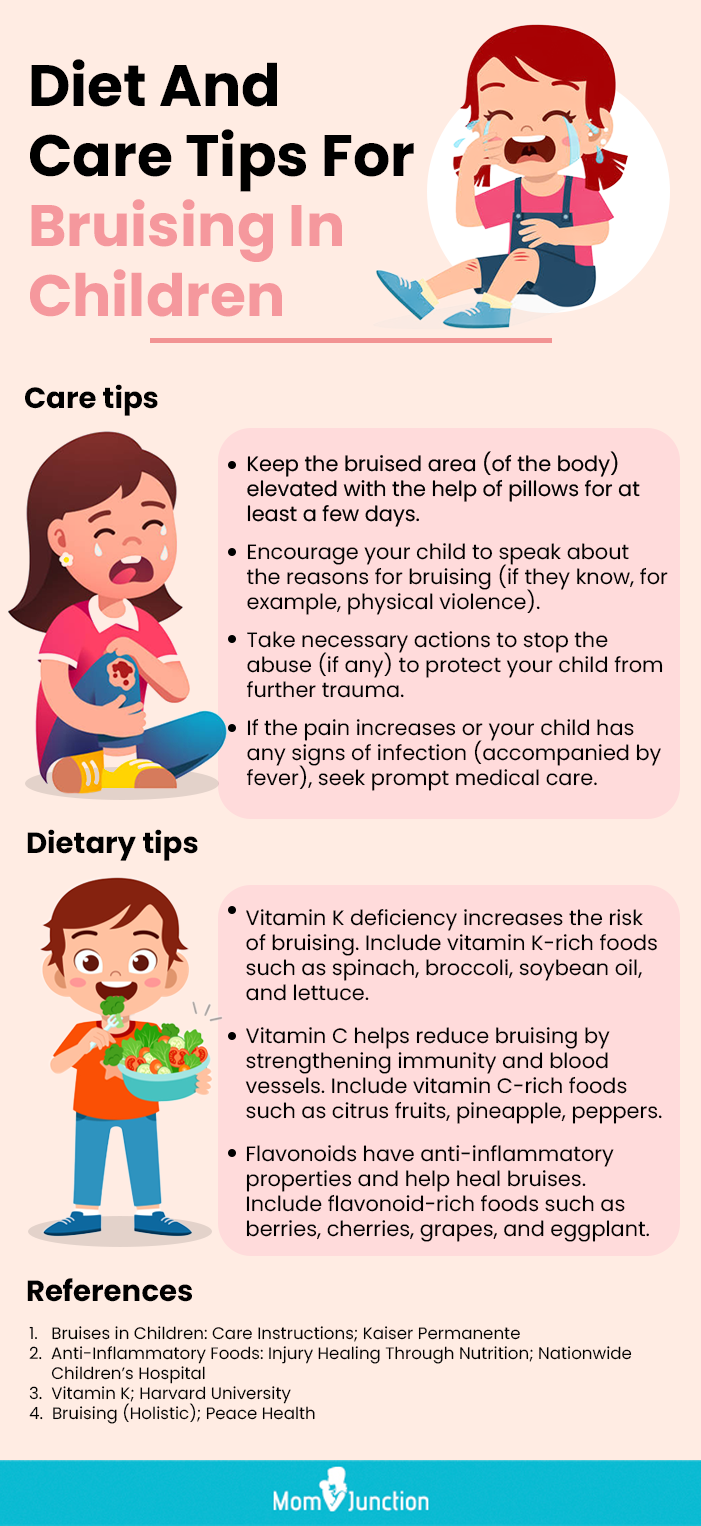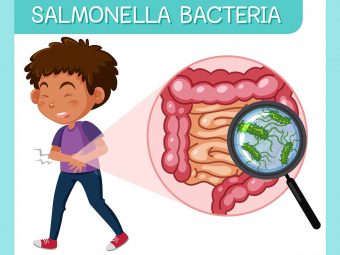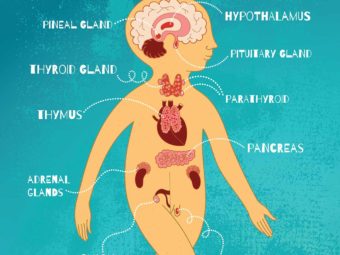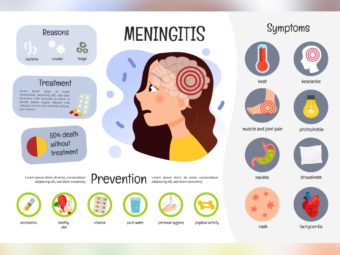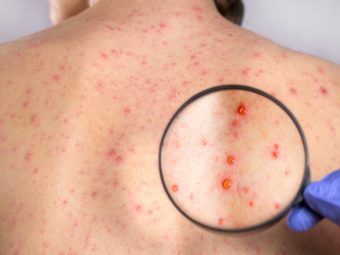
Bruising in children is caused by skin injuries that result in discoloration of the affected sites. When the skin gets bruised, the blood from the damaged blood cells collects under the skin, which causes the bruise to appear deep red, purple, blue, or black. Whether it is a toddler trying to walk or a child learning to play basketball, children often slip over and hit surfaces, bruising different body parts.
Minor bruising or wounds caused by slips, falls, or skids is common and rarely a cause of worry. It can be treated and managed at home and often fades away in a few weeks without medical intervention. However, if your child develops bruises with no identifiable cause, it could indicate an underlying medical problem or physical abuse.
Read on to learn how normal bruising differs from abnormal bruising, the signs of abnormal bruising, and its possible causes, treatment, and prevention.
What Is Normal Bruising In Children?
A bruise often leads to bleeding underneath the skin. It is usually caused by a physical impact on the body by an external object. The tissues near the affected area get compressed, damaging the blood vessels and causing them to bleed.
Bruises or cuts due to minor accidents are generally small, oval to round in shape with nondistinctive borders, and often seen in areas such as the forehead, knee, shins, elbows, and knees (1).
Here is an image of how a normal bruise looks like.
If the bruise on your child’s body is caused by falling or skidding, it heals within three to five days. The bruise that appears red on the first day turns purple or blue in a day and gradually turns to yellowish-brown and peels away (2).
However, if you find bruises on your child’s body for no apparent reason, it is a red flag, and such sudden bruises could be due to an underlying medical condition or abuse. Read on to find out the signs of abnormal bruising in children.
Signs Of Abnormal Bruising In Children
If you spot random bruises that appear in unusual locations on your child’s skin, you need to be wary. Here are a few signs of abnormal bruising.
- Out-of-proportion bruises from a minor or no impact. For example, a huge bruise for a small bump
- Sudden bruises without any history of trauma or accident
- Bruises that do not heal even after weeks of occurrence
- Family history of bleeding disorders, such as Von Willebrand disease or hemophiliaiXAn inherited bleeding disorder in which the blood fails to clot after an injury or the person has spontaneous bleeding
- Bruises on babies who have not yet started crawling
- Occurrence of sudden bruises on unusual places, such as the ears, neck, feet, chest, buttocks, abdomen, or genitalia
- Large bruises
- Frequent nose bleeds or excessive bleeding after a dental procedure or a minor surgery
- Clustered or patterned bruises such as handprints, belt marks, or bite marks (1)
If you notice any of the above signs in your child, it is important to know the root cause. The next section covers the various reasons for abnormal bruising.
Causes Of Abnormal Bruising
As your toddler starts taking their first steps, they might trip and bump into many things, leading to bruises, or your child might come home with a new bruise after playing at school. Normal bruises are a part of childhood and are a sign that your child is trying new things.
However, if you see sudden and abnormal bruises on your child’s body, it is best to know the cause behind it. The bruise could be due to any of the reasons given below.
- Child abuse: If your child gets unexplained bruises in places such as the upper arms, hands, cheeks, buttocks, and genitalia, and if the bruises look like bite marks, cigarette burns, or belt marks, it might be child abuse (3). According to the US Department of Health & Human Services’s Child Maltreatment Report 2021, about 6,00,000 children were victims of child abuse in the US in that year. Determining if the child’s bruises are due to abuse or otherwise is essential to protect them from potential harm and ensure their well-being.
If abuse is ruled out, certain medical conditions might be the cause of the sudden bruising in your child. Below are the names and details of such disorders.
 Be watchful
Be watchful- Thrombocytopenia: Thrombocytopenia is a condition in which your blood has a lower than normal platelet count. It could lead to internal bleeding or bleeding underneath your skin or from the surface of your skin. It is often characterized by skin bruises and red, pinpoint, round spots on the skin (petechiae). CorticosteroidsiXAlso known as steroids, they resemble the hormones secreted by the adrenal gland and can be used to treat different diseases , intravenous immunoglobulinsiXA medical treatment where antibodies are transferred to a person intravenously/through the veins , and blood or platelet transfusions, and splenectomyiXA surgery to remove the spleen are some treatment options available for severe thrombocytopenia (4).
- Von Willebrand disease: This is a common bleeding disorder seen in approximately 1% of children. It occurs due to the lack of or abnormalities in the protein known as von Willebrand factor in the body, causing easy bruising, nose bleeding, oral cavity bleedings, and heavy menstrual periods in the case of adolescent females. Treatments options include antifibrinolytic agentsiXDrugs used to prevent heavy bleeding in hemophilia during menstruation or surgery and transfusion with plasma concentratesiXWhen plasma, the liquid portion of blood, is given to a person with illnesses like hemophilia or severe infections (5).
- Hemophilia A and B: These are bleeding disorders linked to the mutations in genes responsible for the production of coagulation factors VIII and IX. If not managed in early infancy, they can lead to chronic diseases or lifelong disabilities. Children with hemophilia show abnormal bruising or bleeding, bleeding in the joints, bleeding after incisions or losing a tooth, and frequent nosebleeds. Treatment includes infusing commercially prepared clotting factors regularly (6).
- Leukemia: This is a common cancer of the blood, wherein the cancerous cells grow in the bone marrow and get circulated into the blood. Bruising and bleeding are some of the common symptoms of leukemia. The bruises appear in unusual places, such as the face, buttocks, ears, chest, and head. These bruises last long and even grow in size. Other leukemia symptoms include fatigue, pale skin, shortness of breath, and loss of appetite (7), (8).
 Research finds
Research finds- Childhood IgA Vasculitis: Formerly known as Henoch Schonlein PurpuraiXA purple-colored patch that appears on the skin and the mucus membrane due to leakage of blood and other reasons , this blood disorder can occur in children of any age, but the symptoms peak at four to six years. This condition occurs due to abnormalities in immunoglobulin A (IgA), a major antibody that is present in the mucosal secretions and serves as the first line of defense against invasion by pathogens. Symptoms include sudden onset of bruises, purpura, mucosal hemorrhageiXPresence of blood in the mucus membranes , and petechiaeiXRed, brown, or purple-colored pinpoint round dots on the skin that look like a rash and are a result of bleeding . Most IgA cases in children improve on their own and do not require any specific treatment (9).
- Factors II and V deficiency: Sudden bruising and bleeding disorders occur in children when they are born with deficiencies of coagulationiXThe process of thickening of a liquid, usually blood factors prothrombin (FII) and proaccelerin (FV), which serve an important role in blood clotting. The deficiency of these factors in the body is characterized by bleeding gums, nosebleeds, sudden bruises, and prolonged bleeding after an injury. It may be treated through plasma transfusion (10) (11).
- Vitamin K deficiency: Bruising and bleeding in children can also occur due to vitamin K deficiency. Vitamin K proteins play an important role in coagulation, bone development, and cardiovascular health (12). Vitamin K transport across the placenta is generally poor in babies, so watch out for symptoms such as bruises around the head and face and bleeding from the nose. According to the National Institute of Health, the dietary intake of Vitamin K for children should be 30mcg–60mcg (13). Treatment options include vitamin K shots or dietary intake.
Apart from the above causes, medicines, such as aspirin, and some antibiotics can also cause bruises in children (14).
When To See The Doctor?
If you notice a recurring pattern of bruises in your children, with no known cause, it is best to consult your pediatrician. Take your child to the doctor if you notice any bleeding disorders or see any of the below signs.
- Unexplained bruises in a recurring pattern
- Painless bruises
- Random bruises without signs of injury
- Black bruises on the legs or other unusual places
- Limping due to bruising
Besides a physical examination, your doctor might prescribe tests, such as a complete blood count, peripheral blood smear, and bleeding time, to determine the functioning of the clotting factors and diagnose bleeding disorders.
Treatment Of Bruises In Children
If the bruises are due to minor trauma, they could be treated at home by applying an ice pack or prescribing over-the-counter medication to reduce pain, tenderness, and swelling.
Random bruising can also be caused if your child is being subjected to abuse that you are not aware of. If your child has to spend time with a babysitter or at the daycare, make sure your child is in safe hands. Still, if you find suspicious bruising, it is best to consult child welfare authorities, as childhood abuse is deeper than the bruise.
If the bruises are abnormal and your child is diagnosed with bleeding disorders, follow the treatment prescribed by your doctor.
Prevention Of Bruising In Children
When your child is growing up and exploring the world, it might not be possible to prevent bruising, as it is a part of the growing-up process. However, you can help your child avoid bruises to some extent by instructing them to wear shin, shoulder, knee, and thigh guards.
Most bleeding disorders need to be managed with the utmost care. If your child is diagnosed with a disorder, talk to your health care provider and gather as much information as possible. Also, explain the disorder to your child, and tell them the importance of taking certain precautions.
Frequently Asked Questions
1. What does bruising from leukemia look like?
Bruises caused by leukemia occur in unusual places, such as the back and hands. Besides, multiple bruises usually occur without any prominent cause or reason (7).
2. Why are my child’s legs always bruised?
It isn’t unusual for active children to get bruised frequently. Children usually get bruises due to bumps and falls. However, you should speak to a doctor if you see multiple bruises without apparent cause.
3. Which of the body locations are areas of normal bruising on a child?
According to experts, accidental bruising in active children can be commonly seen on the knees, elbows, forehead, nose, chin, and head (15).
4. How long do bruises last?
Bruises occur when small blood vessels under the skin are damaged, allowing blood to leak into surrounding tissue. Initially, there may be some redness and swelling. Within 24 hours, the leaked blood often turns blue, purple, or black as it loses oxygen. Over the next two to seven days, the bruised area typically turns green or yellow as old red blood cells break down. The exact timeline varies between people and depends on factors like the severity of the injury. Most minor bruises heal completely within 10-14 days. More serious bruises like hematomas may take longer to resolve. If a bruise seems unusually large or severe given the cause, persists beyond two weeks, or occurs without injury, it should be evaluated by a doctor (16).
Bruised skin is common in children as they fall and hurt themselves, especially when young. Due to the impact of a fall, the tissues and blood vessels under the skin might get compressed and damaged or swollen leading to discoloration of the skin and a bruised appearance. If you notice any bruising that appears on the skin for no reason or does not resolve for days, you should seek a healthcare professional’s advice. Furthermore, any abnormal marks, such as bite marks, finger marks, or other abnormal items, must be reported promptly, particularly for children who spend time with caregivers or at daycare centers.
Infographic: Caring And Dietary Tips For A Child’s Bruising
Bruises are not uncommon in children during their growing years; also, mild bruising is easily manageable with simple remedies at home. Here is an infographic that details ways to care for your child and what foods to give to reduce bruising. Illustration: Momjunction Design Team
Key Pointers
- Normal bruising and bleeding underneath the skin are commonly caused when children slip over or hit surfaces.
- It is worrisome if no apparent cause can be identified or is at unusual places such as ears, neck, buttocks, or genitalia.
- Abnormal bruising may indicate child abuse or an underlying health issue such as blood clotting disorders and requires medical attention.
Bumps and bruises are a normal part of growing up. Learn what’s normal and when to be concerned in this informative video.
References
1. Michelle GK Ward, et al.; The medical assessment of bruising in suspected child maltreatment cases: A clinical perspective; Pediatrics Child Health (2013).
2.Is it More Than a Bruise?; Children’s Hospital Colorado
3. James D. Anderst, et al.; Evaluation for Bleeding Disorders in Suspected Child Abuse; American Academy of Pediatrics (2013)
4. Thrombocytopenia; National Institutes of Health
5. Robert J Klaassen and Jacqueline M Halton; The diagnosis and treatment of von Willebrand disease in children; Pediatrics Child Health (2002).
6. What is Hemophilia?; Centers for Disease Control and Prevention
7. Bruising in leukemia VS ordinary bruising; Leukemia Care
8. Signs and Symptoms of Childhood Leukemia; American Cancer Society
9. Louise Oni and Sunil Sampath; Childhood IgA Vasculitis (Henoch Schonlein Purpura)—Advances and Knowledge Gaps; Frontiers in Pediatrics (2019).
10. Prothrombin Deficiency; National Institute of Health
11. Amol Chingale, et al.; A neonatal presentation of factor V deficiency: A case report; BMC Pediatrics (2007).
12. Rina E. Eden and Jean M. Coviello; Vitamin K Deficiency; StatPearls (2020).
13. Vitamin K; National Institutes of Health
14. Bruises and Blood Spots Under the Skin; C.S. Mott Children’s Hospital
15. More than just a bruise: Recognizing child physical abuse; British Columbia Medical Journal
16. More than just a bruise: My Child Has a Bruise: When Should I Worry?; BNationwide Children’s Hospital





